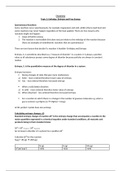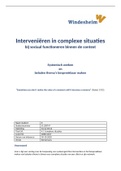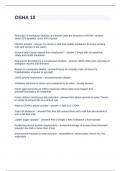1CVK00: Supply Chain Management
Bullwhip effect
Bullwhip effect: The phenomenon where orders to the supplier tend to have a larger variance than sales to the buyer, and the
distortion tends propagates upstream in an amplified form.
• Also known as Forrester effect.
2
𝜎𝑂
• Direct measure of bullwhip at 1 single stock point: 𝐵𝑊𝑂 = 2
𝜎𝐷
o If 𝐵𝑊𝑂 > 1, then there exists amplification in the system.
Structural causes
• Price fluctuations
Lower prices incentivize higher orders. When the incentives are right, products are ordered in larger quantities than needed,
the items are stocked up (forward buying). However, stocking-up implies that future orders will be lower to compensate.
• Order batching
Caused by periodic ordering.
If you observe demand daily, but order every other week, your orders will be larger and more variable than your demand. This
leads to trouble for your supplier when your customers orders are spread out, the effect is dampened. when they all order
around the same period (e.g. beginning of the month, then the effect is amplified).
• Shortage gaming
When demand exceeds supply, suppliers will allocate.
o E.g.: you place an order for 20 units, but only receive 10.
It is very tempting to extrapolate, and next period order 40, in order to receive appr. 20.
This sends a wrong signal to the supplier, who will increase production.
The customer just cancels all the extra orders.
When lead time suddenly increases, you want to have more safety stock, so you would order more than usual.
• Demand forecast updating
All companies do demand forecasting to better adjust to changing demand patterns and adjust their orders accordingly.
o So, with each new observation we update the forecast.
o With each update of the forecast, we update the order-up-to policy
o Consequences:
▪ Poor product forecasts.
▪ Excessive inventory.
▪ Insufficient or excessive capacities.
▪ Poor customer service due to unavailable products or long backlogs.
▪ Many revisions in production/workforce planning.
▪ High costs for corrections, such as for expedited shipments and overtime.
Solutions
Structural causes Solution Implementation
Price fluctuations Stabilize prices (prevent forward-buying). E.g., through EDLP rather than High-Low pricing.
Order batching Reduce fixed ordering costs. E.g., through EDI.
Shortage gaming Minimize excessive orders. E.g., allocate based on past sales rather than orders, use
your direct-to-consumer channel to gauge actual
customer demand.
Demand forecast updating Information sharing (eliminate multiple E.g., through VMI
demand forecasts in the supply chain (SC)).
Behavioural causes
• We already learned that there are structural causes to the Bullwhip effect In other words, there is no way to escape it, even
when you think you are doing everything right mathematically (demand forecasting, setting the right order up to levels).
• The beer game shows that mental models also play a role in the Bullwhip effect.
o It is consistently observed that when playing the beer game, most people forget about the lead times, and
ignore/underestimate the supply line (even though this is shown in the system). This leads to aggressive ordering
when faced with backorders, or no ordering when there is inventory -> makes the system very unstable.
1
, Coordination
How well 1 echelon (e.g., retailer) performs depends on the decisions made by other echelons (e.g., consumers/wholesalers/producers).
SC performance depends on actions taken by all the echelons in the SC. If the SC does better, then most likely everyone in it will do better.
Underage cost 𝒄𝒖 : when the total demand in the period exceeds the stock available.
• 𝑐𝑢 = 𝑝 − 𝑣 + 𝐵
o 𝑝 = revenue per sale [€/unit]
o 𝑣 = unit variable cost [€/unit]
o 𝐵 = penalty for not satisfying demand [€/unit]
Overage cost 𝒄𝒐 : when the total demand is less than the stock available.
• 𝑐𝑜 = 𝑣 − 𝑠
• 𝑠 = salvage value
Optimal order quantity
𝑐𝑢
• 𝐹(𝑄 ∗ ) = 𝑃(𝐷 ≤ 𝑄 ∗ ) = = Critical ratio
𝑐𝑢 +𝑐𝑜
• Find 𝑄∗ using the appropriate z-stat.
𝑐𝑢
o 𝑧 = Φ−1 ( )
𝑐𝑢 +𝑐𝑜
𝐶𝑢
o 𝑄 ∗ = 𝜇 + 𝑧𝜎 = min{𝑄: 𝑃(𝑋 ≤ 𝑄) ≥ }
𝐶𝑜 +𝑐𝑢
Expected lost sales = 𝜎𝐿(𝑧)
Expected sales = 𝜇 − Expected lost sales
Expected leftovers = 𝑄 ∗ − Expected sales
Expected profit = 𝑐𝑢 ⋅ Expected sales −𝑐𝑜 ⋅ Expected leftovers
Marginal cost pricing: Supplier only charges the retailer the marginal cost in order to reach the optimal supply chain profit.
Mechanisms to optimize the whole SC
• Buy back contracts:
o At the end of the season, the supplier buys back the retailer’s leftover inventory at a higher price than salvage price.
o Purpose: lowering the overage cost of having additional inventory at the retailer.
o Then, the overages are less costly, so retailer stocks more.
▪ Lower 𝑐𝑜 → higher critical ration → higher order quantity (closer to the SC order quantity)
o This allows for the redistribution of inventory risk across the SC, potentially making everyone in the SC better off if
the contract terms are decided carefully.
o Optimal buyback price is the price that makes the retailer order the SC 𝑄 ∗ .
o Optimal buy-back price does not guarantee to make everyone in the SC better off.
1) There exists a buy-back contract with the right terms/incentives to make the total SC profit better off,
and everyone involved in the SC better off (including the retailer, supplier, and consumers).
o Best suited for products with low return costs (which adds additional cost to the supply chain).
o Very common in the book industry -> publishers accept unsold books from retailers.
▪ To minimize the cost associated with the physical return process, retailers do not have to return the book,
only the cover → provides proof that the book did not sell.
• Holding cost subsidies
o Manufacturers pay retailers a certain amount for every unit held in the inventory.
o Purpose: lowering the costs associated with holding inventory → so, more inventory is pushed to the retailer.
o Prevalent in automotive industries.
• Price support
o When the price drops, the manufacturer subsidizes for the difference (provides price support).
o Purpose: the risk of holding inventory is reduced, so the retailer orders more.
o Used in high-tech industries where products lose value rapidly → high risk of holding inventory → high overstocking cost.
• Revenue-sharing contract
o The manufacturer sells the item to the retailer for cheaper, i.e., lower 𝑤.
o But then, gets a percentage 𝑝 of the retailer’s revenue from its sales (i.e., share the retailer’s revenue).
o Best suited for products with high return costs.
o Requires a lot of trust and/or sales monitoring scheme so the manufacturer knows exactly how much the retailer sold.
o Revenue-sharing contracts are used not only in vertical collaboration (as we study), but also in horizontal collaboration.
▪ Very popular in the airline industry, e.g., between KLM and Delta airlines.
Conclusion
• SC performance may be less than optimal because decentralized firms choose individually optimal actions (local optimization).
• The terms of trade do not give firms the proper incentive to choose SC optimal actions.
• Various contracts/mechanisms are aimed to design proper incentives so even when firms choose local optimization, they get
close to the maximum SC performance.
• With the right incentives, everyone can be better off (the individual firms, as well as the SC).
2
Bullwhip effect
Bullwhip effect: The phenomenon where orders to the supplier tend to have a larger variance than sales to the buyer, and the
distortion tends propagates upstream in an amplified form.
• Also known as Forrester effect.
2
𝜎𝑂
• Direct measure of bullwhip at 1 single stock point: 𝐵𝑊𝑂 = 2
𝜎𝐷
o If 𝐵𝑊𝑂 > 1, then there exists amplification in the system.
Structural causes
• Price fluctuations
Lower prices incentivize higher orders. When the incentives are right, products are ordered in larger quantities than needed,
the items are stocked up (forward buying). However, stocking-up implies that future orders will be lower to compensate.
• Order batching
Caused by periodic ordering.
If you observe demand daily, but order every other week, your orders will be larger and more variable than your demand. This
leads to trouble for your supplier when your customers orders are spread out, the effect is dampened. when they all order
around the same period (e.g. beginning of the month, then the effect is amplified).
• Shortage gaming
When demand exceeds supply, suppliers will allocate.
o E.g.: you place an order for 20 units, but only receive 10.
It is very tempting to extrapolate, and next period order 40, in order to receive appr. 20.
This sends a wrong signal to the supplier, who will increase production.
The customer just cancels all the extra orders.
When lead time suddenly increases, you want to have more safety stock, so you would order more than usual.
• Demand forecast updating
All companies do demand forecasting to better adjust to changing demand patterns and adjust their orders accordingly.
o So, with each new observation we update the forecast.
o With each update of the forecast, we update the order-up-to policy
o Consequences:
▪ Poor product forecasts.
▪ Excessive inventory.
▪ Insufficient or excessive capacities.
▪ Poor customer service due to unavailable products or long backlogs.
▪ Many revisions in production/workforce planning.
▪ High costs for corrections, such as for expedited shipments and overtime.
Solutions
Structural causes Solution Implementation
Price fluctuations Stabilize prices (prevent forward-buying). E.g., through EDLP rather than High-Low pricing.
Order batching Reduce fixed ordering costs. E.g., through EDI.
Shortage gaming Minimize excessive orders. E.g., allocate based on past sales rather than orders, use
your direct-to-consumer channel to gauge actual
customer demand.
Demand forecast updating Information sharing (eliminate multiple E.g., through VMI
demand forecasts in the supply chain (SC)).
Behavioural causes
• We already learned that there are structural causes to the Bullwhip effect In other words, there is no way to escape it, even
when you think you are doing everything right mathematically (demand forecasting, setting the right order up to levels).
• The beer game shows that mental models also play a role in the Bullwhip effect.
o It is consistently observed that when playing the beer game, most people forget about the lead times, and
ignore/underestimate the supply line (even though this is shown in the system). This leads to aggressive ordering
when faced with backorders, or no ordering when there is inventory -> makes the system very unstable.
1
, Coordination
How well 1 echelon (e.g., retailer) performs depends on the decisions made by other echelons (e.g., consumers/wholesalers/producers).
SC performance depends on actions taken by all the echelons in the SC. If the SC does better, then most likely everyone in it will do better.
Underage cost 𝒄𝒖 : when the total demand in the period exceeds the stock available.
• 𝑐𝑢 = 𝑝 − 𝑣 + 𝐵
o 𝑝 = revenue per sale [€/unit]
o 𝑣 = unit variable cost [€/unit]
o 𝐵 = penalty for not satisfying demand [€/unit]
Overage cost 𝒄𝒐 : when the total demand is less than the stock available.
• 𝑐𝑜 = 𝑣 − 𝑠
• 𝑠 = salvage value
Optimal order quantity
𝑐𝑢
• 𝐹(𝑄 ∗ ) = 𝑃(𝐷 ≤ 𝑄 ∗ ) = = Critical ratio
𝑐𝑢 +𝑐𝑜
• Find 𝑄∗ using the appropriate z-stat.
𝑐𝑢
o 𝑧 = Φ−1 ( )
𝑐𝑢 +𝑐𝑜
𝐶𝑢
o 𝑄 ∗ = 𝜇 + 𝑧𝜎 = min{𝑄: 𝑃(𝑋 ≤ 𝑄) ≥ }
𝐶𝑜 +𝑐𝑢
Expected lost sales = 𝜎𝐿(𝑧)
Expected sales = 𝜇 − Expected lost sales
Expected leftovers = 𝑄 ∗ − Expected sales
Expected profit = 𝑐𝑢 ⋅ Expected sales −𝑐𝑜 ⋅ Expected leftovers
Marginal cost pricing: Supplier only charges the retailer the marginal cost in order to reach the optimal supply chain profit.
Mechanisms to optimize the whole SC
• Buy back contracts:
o At the end of the season, the supplier buys back the retailer’s leftover inventory at a higher price than salvage price.
o Purpose: lowering the overage cost of having additional inventory at the retailer.
o Then, the overages are less costly, so retailer stocks more.
▪ Lower 𝑐𝑜 → higher critical ration → higher order quantity (closer to the SC order quantity)
o This allows for the redistribution of inventory risk across the SC, potentially making everyone in the SC better off if
the contract terms are decided carefully.
o Optimal buyback price is the price that makes the retailer order the SC 𝑄 ∗ .
o Optimal buy-back price does not guarantee to make everyone in the SC better off.
1) There exists a buy-back contract with the right terms/incentives to make the total SC profit better off,
and everyone involved in the SC better off (including the retailer, supplier, and consumers).
o Best suited for products with low return costs (which adds additional cost to the supply chain).
o Very common in the book industry -> publishers accept unsold books from retailers.
▪ To minimize the cost associated with the physical return process, retailers do not have to return the book,
only the cover → provides proof that the book did not sell.
• Holding cost subsidies
o Manufacturers pay retailers a certain amount for every unit held in the inventory.
o Purpose: lowering the costs associated with holding inventory → so, more inventory is pushed to the retailer.
o Prevalent in automotive industries.
• Price support
o When the price drops, the manufacturer subsidizes for the difference (provides price support).
o Purpose: the risk of holding inventory is reduced, so the retailer orders more.
o Used in high-tech industries where products lose value rapidly → high risk of holding inventory → high overstocking cost.
• Revenue-sharing contract
o The manufacturer sells the item to the retailer for cheaper, i.e., lower 𝑤.
o But then, gets a percentage 𝑝 of the retailer’s revenue from its sales (i.e., share the retailer’s revenue).
o Best suited for products with high return costs.
o Requires a lot of trust and/or sales monitoring scheme so the manufacturer knows exactly how much the retailer sold.
o Revenue-sharing contracts are used not only in vertical collaboration (as we study), but also in horizontal collaboration.
▪ Very popular in the airline industry, e.g., between KLM and Delta airlines.
Conclusion
• SC performance may be less than optimal because decentralized firms choose individually optimal actions (local optimization).
• The terms of trade do not give firms the proper incentive to choose SC optimal actions.
• Various contracts/mechanisms are aimed to design proper incentives so even when firms choose local optimization, they get
close to the maximum SC performance.
• With the right incentives, everyone can be better off (the individual firms, as well as the SC).
2




